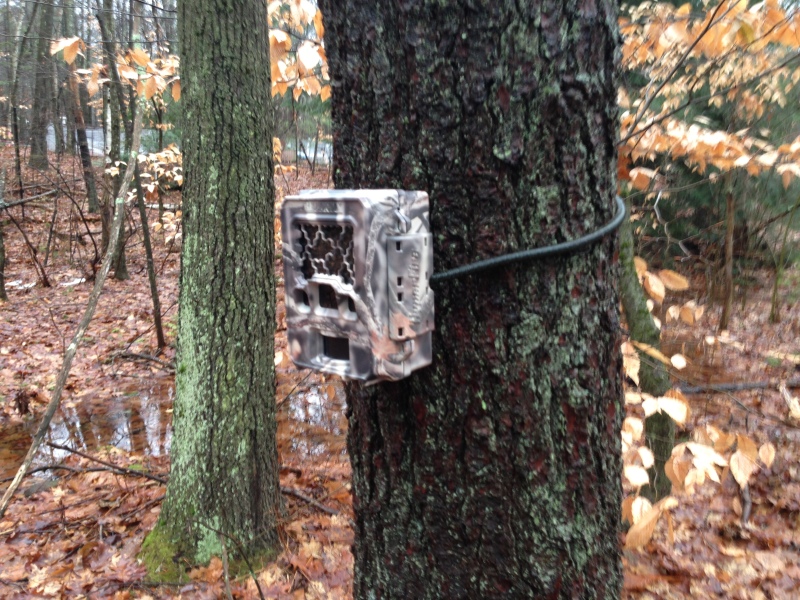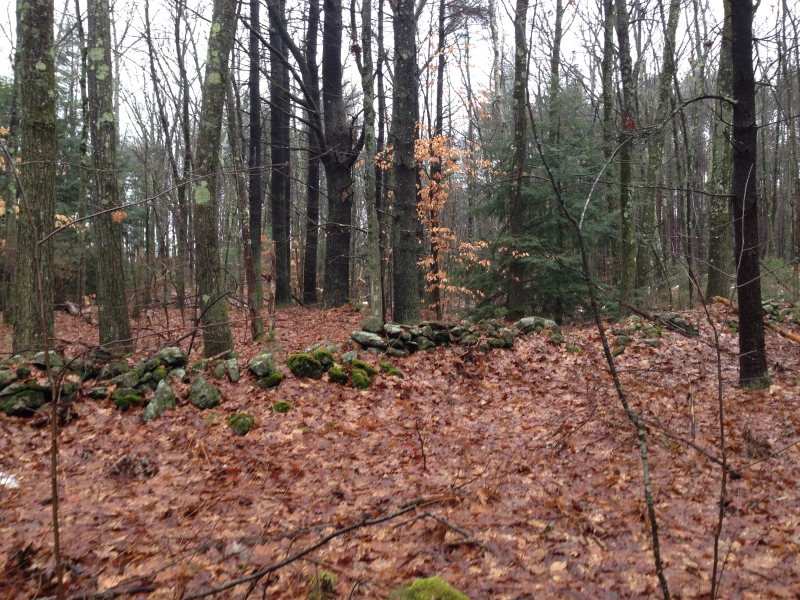A WINDOW INTO THE ANIMAL WORLD
With a tug, this morning I pulled the bungee cord tight, attaching a wildlife camera to a tree near the big red oak I am studying this year at the Harvard Forest. My tree’s neighborhood is now under surveillance.
Is my tree the most-monitored red oak in history? BT QURU 03 is a tagged, tracked research specimen in a long-term study of the seasonal gyre of the forest. Every week, during fall and spring, John O’Keefe, Harvard Forest field phenologist, checks the status of its canopy, noting when in spring its buds swell, leaves open, and grow, and then in the fall, when they color, and drop. The Richardson Lab at Harvard University monitors the tree’s canopy and environment with an array of instruments, including a Web cam on a tower observing the forest where it grows. And I am tracking it too, with another Web cam purchased by the Knight program in Science Journalism at MIT.
Some of my collaborators here at the forest helped me set it up right at my tree’s trunk, to observe this tree’s individual canopy through the seasonal year. Images from the Barn Tower Web Cam on the tower, and the Witness Tree Web Cam at the foot of my tree are uploaded to the Harvard Forest web site every half hour, during daylight hours, 24/7. Have a look.
Now, thanks to David Foster, director of the Harvard Forest, there’s a wildlife camera on the case too. It’s a good camera. Set to take a photo anytime it senses motion, it will record the doings in BT QURU 03’s realm.

I put up a wildlife cam this morning to keep track of the animal doings in my tree’s neighborhood. Thanks to David Foster, director of the Harvard Forest for this new look into the world of my tree.
Why all this attention? This big, grand tree is the main character in my book, Witness Tree, which I am researching and writing while a Bullard Fellow this year at the Harvard Forest. I’m taking a deep, long look at the tree’s 100 years of human and natural history. Already I am learning that in my micro-history of this one tree, in this one place, there is so much to see: our changing relationship with nature, and even our changing world. Scientists here at the forest know, from long term research, that spring comes here earlier now, fall later, and winter is squeezed on both ends. They know my tree sprouted by a stonewall in about 1905, maybe earlier, the core we took from the tree last June did not reach to its heart.
My tree has witnessed so much change. Its forest is the third in this region. The pre-colonial forest was cleared by European settlers beginning in about 1700, to begin subsistence farming. The chopping continued relentlessly, until about 1830, with about 75 percent of the forest felled for pastures and farm fields. But better transportation was the death knell of small farms clawed from the stony soils here in New England. With the Erie Canal, railroads, and expanded road networks, markets were opened to the better farmlands of the Midwest. Most farmers here abandoned agriculture. Their fields naturally seeded in to almost pure stands of white pine, from the big trees left in corners and borders of the pastures and farm fields.
By the early 1900s, those trees were slicked off too, for boxes, barrels, and more, with loggers using portable mills to saw the trees where they were felled. Then the next forest grew up, the hardwoods and pine we see in the Harvard Forest today – including my oak. A wild sprout, it took root by a stonewall along what since at least the mid-1800s was an unimproved pasture, land use records at the Harvard Forest Archives show.
Along the way, our carbon love affair was cranking up, with millions of Model T automobiles pouring off assembly lines, and people leaving the farms and woods for good, making their living in the industries that both bettered, and worsened our world. The level of atmospheric C02 when my tree sprouted was about 300 parts per million. Today it is 403 and counting. Scientists here can see the physiological effects on the forest. Long-term observations show the faster growth of red oaks – the dominant species in the Harvard Forest — and the destruction of others as temperatures warm, stoking invasive pests. Every hemlock in this forest is expected to be gone within a generation, their lovely, feathery foliage eaten to bits by hemlock wooly adelgid.
What of the animals?
Interestingly, they have been the winners, as New England forests have grown back, in one of the most important reforestations, albeit accidental, in the world. The degree of landscape change in New England over the past 300 years is hard to overstate. The Harvard Forest is a perfect example. Today, this nearly 4,000 acre forest, once a place of broad, sunlit meadows and strolling cattle, lies within the most forested region of the US, with forested connections north through New York into Canada creating critical pathways for wildlife travel.

This is the view the wildlife camera will be monitoring. Trees have returned to the pastures and farm fields once delineated by these old stone walls. And with the trees, have come the animals: bear, moose, deer, wild turkey, beaver, and more.
For as the trees have come back, so have the animals, both through natural migration, and purposeful human reintroduction. Rare enough to warrant a journal entry in the time of Thoreau, deer today are virtual pests. Wild turkeys, bear, moose, coyote, bobcat and beaver populations, all rare or totally absent in the mid-19th century, are booming. Meanwhile, open field species, such as the bobolink meadowlark, are on the decline.
These are not the same forests European settlers first encountered. There are no wolves, for one thing. And the forests are younger, and of more even age class. Missing are the gigantic trees of the pre-colonial forests. And the composition is different, with fewer beech and hemlock, those monarchs of shade. And of course there are no chestnut trees, and no passenger pigeons. It is poignant to read in Thoreau’s journals of the great roosts of these birds in the forests of New England, and the sound of people beating chestnut trees, to shake down their nuts. Sounds we will never hear.
I’m curious to see which animals will show up in the eye of the wildlife camera. Will it be only chipmunks on the stonewall, caching acorns? Perhaps moose or bear will grace us with their presence. One thing I tried to avoid, by pointing the camera away from my tree, and toward the deep woods, is lots of pictures of me.
I think I’ll move the camera monthly, to give it different views and perspectives. It is not baited, by the way; I didn’t want to create a snack bar. Instead what I want is just a little window into my tree’s world. I’ll check the camera every month, and post whatever photos of animals it takes here in the blog.
In the secret life of the night, the quiet dawns, which animals come to visit? What company does my tree keep? I can’t wait to find out.

Leave a Reply